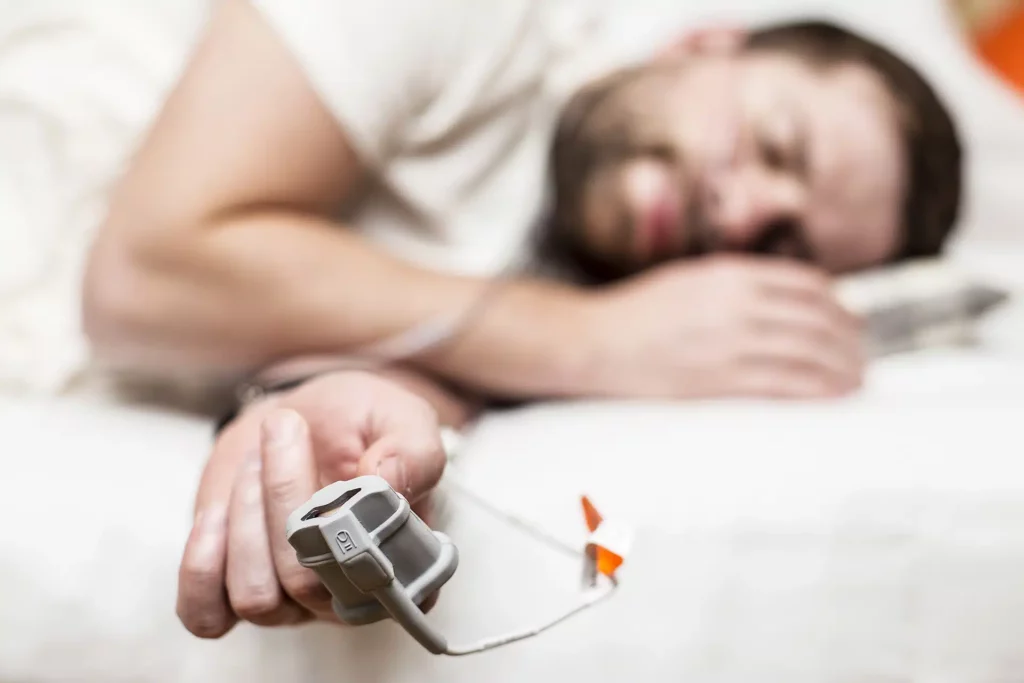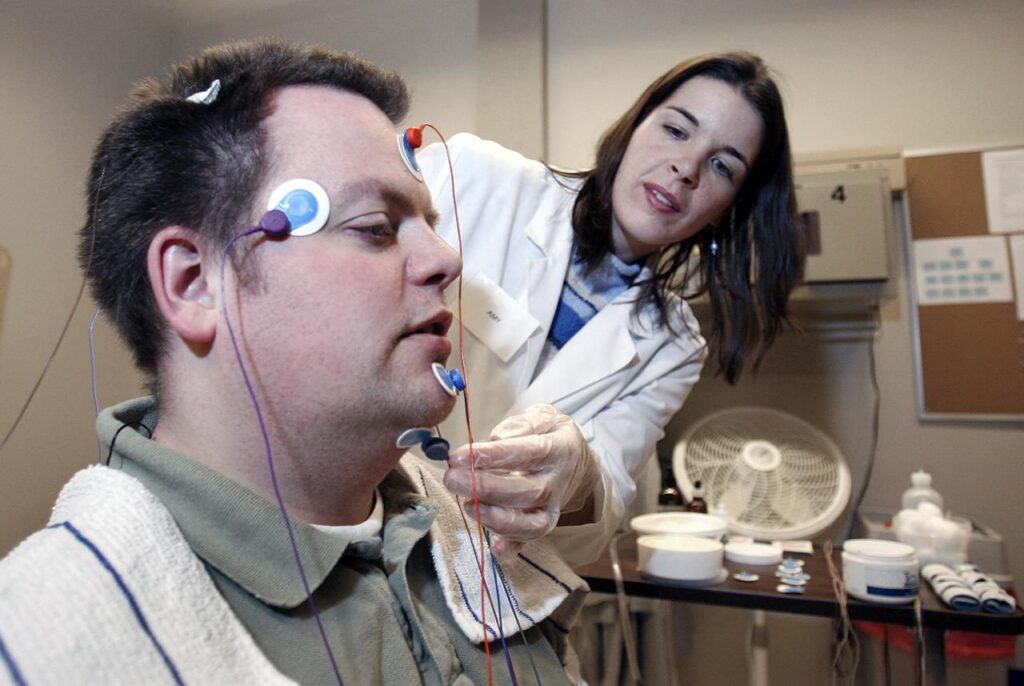Sleep is an essential part of human health and well-being. Understanding how we sleep can help us unlock the secrets to better health, improved cognitive function, and enhanced quality of life. A sleep study test, also known as polysomnography, is a valuable tool that provides insights into our sleep patterns. In this article, we will explore what a sleep study test involves, what it can reveal about our sleep patterns, and how we can leverage this information for better health.
Understanding the Basics of a Sleep Study Test
A sleep study test, or polysomnography, is a comprehensive assessment that records various physiological parameters during sleep. It allows healthcare professionals to monitor brain activity, oxygen levels, heart rate, and respiratory patterns. By analyzing this data, clinicians can gain insights into the different stages of sleep and identify potential sleep disorders.
The Purpose of a Sleep Study Test
The primary purpose of a sleep study test is to diagnose sleep disorders. These disorders can significantly affect a person’s quality of life, leading to issues such as excessive daytime sleepiness, mood disturbances, and cognitive impairments. Identifying the underlying issues through a sleep study can pave the way for effective treatment strategies, helping individuals reclaim their sleep and overall health.
In addition to diagnosing common sleep disorders such as sleep apnea, insomnia, and restless legs syndrome, a sleep study can also help in understanding more complex conditions like narcolepsy or parasomnias. For instance, patients who experience sudden episodes of sleep during the day may benefit from a sleep study that tracks their sleep architecture and daytime sleepiness. This comprehensive approach ensures that all aspects of a patient’s sleep health are thoroughly evaluated, leading to more tailored and effective interventions.

The Process of a Sleep Study Test
Typically, a sleep study is conducted in a sleep laboratory, although home sleep tests are becoming increasingly popular. The process begins with the patient arriving at the lab, where they are connected to various monitoring devices. These devices track brain waves, oxygen saturation, heart rate, and other vital signs throughout the night.
The patient is then asked to sleep as normally as possible while the data is collected. The entire procedure usually takes place overnight, allowing for a complete cycle of sleep to be recorded. In cases where home testing is performed, the individual uses a simplified device that captures essential sleep data in the comfort of their home. This option can be particularly appealing to those who may feel anxious about sleeping in an unfamiliar environment, as it allows for a more relaxed and natural sleep experience. Find more about environment at https://www.epa.gov/education/what-environmental-education
Throughout the night, trained sleep technicians monitor the data collection, ensuring that all parameters are accurately recorded. They may also observe the patient through a video feed, allowing for real-time adjustments if necessary. After the study is completed, the gathered data is analyzed by a sleep specialist, who interprets the findings and discusses them with the patient during a follow-up appointment. This thorough analysis not only aids in diagnosing sleep disorders but also provides valuable insights into lifestyle factors that may be contributing to sleep issues, such as stress levels, diet, and exercise habits.
Unraveling the Mysteries of Sleep Patterns
Understanding sleep patterns is crucial for determining overall health. Healthy sleep is not merely a lack of wakefulness but involves several stages, including light sleep, deep sleep, and REM (rapid eye movement) sleep. Each stage serves unique functions that are essential for physical and mental recovery. During deep sleep, the body engages in critical repair processes, such as tissue growth and muscle repair, while REM sleep plays a vital role in emotional regulation and memory consolidation. This intricate dance of sleep stages underscores the importance of not only the quantity of sleep but also its quality.
Read about home sleep test Australia on: Home Sleep Test Australia
The Importance of Healthy Sleep Patterns
Healthy sleep patterns contribute to numerous benefits, including improved mood, better cognitive function, and enhanced physical health. Adequate sleep helps regulate hormones, supports immune function, and promotes optimal brain function. Research has shown that individuals who maintain consistent sleep schedules are more likely to experience better emotional resilience and lower levels of anxiety. Conversely, disrupted sleep patterns can lead to various health issues, such as obesity, diabetes, and cardiovascular diseases. The long-term effects of poor sleep can also manifest in chronic conditions, making it imperative to prioritize sleep as a fundamental aspect of overall wellness. To read more about diabetes click here.
Common Disruptions in Sleep Patterns
Several factors can disrupt healthy sleep patterns, including stress, lifestyle choices, and medical conditions. Common sleep disorders associated with these disruptions include insomnia, obstructive sleep apnea, and restless legs syndrome. Stressful life events, such as job changes or personal loss, can trigger insomnia, while lifestyle choices like excessive screen time before bed can hinder the body’s natural sleep-wake cycle. Recognizing and addressing these disruptions is key to restoring healthy sleep. Additionally, environmental factors such as noise, light, and temperature can significantly impact sleep quality, highlighting the importance of creating a conducive sleep environment. Simple adjustments, such as using blackout curtains or white noise machines, can make a substantial difference in achieving restorative sleep.
What Sleep Study Tests Can Detect
Sleep study tests are instrumental in identifying a range of sleep disorders that can affect overall health. Through detailed analysis of sleep patterns and physiological data, healthcare providers can diagnose specific conditions and recommend appropriate interventions. These tests are typically conducted in a sleep lab or at home, using advanced technology to monitor various bodily functions during sleep, ensuring a thorough evaluation of the individual’s sleep health.
Sleep Disorders and Their Symptoms
Common sleep disorders that can be detected through sleep studies include:
- Obstructive Sleep Apnea: Characterized by repeated interruptions in breathing during sleep, often accompanied by loud snoring and excessive daytime sleepiness.
- Insomnia: Difficulty falling or staying asleep, leading to daytime fatigue and irritability.
- Restless Legs Syndrome: An uncontrollable urge to move the legs, often occurring in the evening or when at rest.
- Narcolepsy: Irregular sleep patterns involving excessive daytime sleepiness and sudden sleep attacks.
The Role of Sleep Study in Diagnosis
Sleep studies play a critical role in the diagnosis of these disorders by providing objective data on sleep architecture and disturbances. Clinicians analyze the recorded data, such as brain activity and breathing patterns, to develop a comprehensive understanding of the patient’s sleep quality. This information can guide treatment decisions, helping patients find appropriate care. Furthermore, sleep studies can also reveal underlying health issues that may not be immediately apparent, such as cardiovascular problems or metabolic disorders, which can be exacerbated by poor sleep quality.
In addition to traditional polysomnography, there are various types of sleep studies, including home sleep apnea testing (HSAT) and actigraphy. Home sleep apnea testing allows patients to undergo monitoring in the comfort of their own homes, making it a more convenient option for many. Actigraphy, on the other hand, involves wearing a wrist device that tracks movement patterns over time, providing insights into sleep-wake cycles and overall sleep duration. These alternative methods expand the accessibility of sleep assessments, ensuring that more individuals can receive the evaluation they need to improve their sleep health.
Interpreting the Results of a Sleep Study Test
Once a sleep study is completed, the data collected is analyzed by a sleep specialist. Understanding this analysis is crucial for patients seeking answers to their sleep issues.
Understanding Sleep Study Test Results
Results from a sleep study typically include graphs and charts depicting various metrics like sleep stages, the number of apneas, and oxygen levels during sleep. A sleep specialist will explain these results to the patient, helping them understand their sleep patterns and any identified issues. For instance, patients may learn about the different stages of sleep—light sleep, deep sleep, and REM sleep—and how disruptions in these stages can affect overall health. Additionally, the report may highlight any irregularities, such as periodic limb movements or unusual breathing patterns, which can provide further insight into the patient’s sleep quality.

Next Steps After a Sleep Study Test
Following the interpretation of the sleep study results, patients may receive recommendations for further evaluation or treatment options. This could include lifestyle modifications, cognitive-behavioral therapy for insomnia, or the use of continuous positive airway pressure (CPAP) devices for obstructive sleep apnea. The goal is to tailor a treatment plan that meets the individual’s needs and improves their quality of sleep. In some cases, patients might be advised to keep a sleep diary to track their sleep habits and any changes they make, which can help the specialist fine-tune the treatment approach. Furthermore, discussions about potential follow-up appointments or additional testing may arise, ensuring that the patient remains engaged and informed throughout their journey toward better sleep health.
Improving Sleep Patterns Post Sleep Study
Armed with insights from their sleep study, individuals can take proactive steps towards improving their sleep patterns. Making informed changes can lead to significant enhancements in sleep quality and overall health.
Lifestyle Changes for Better Sleep
Several lifestyle changes can promote healthier sleep patterns, including:
- Establishing a Consistent Sleep Schedule: Going to bed and waking up at the same time each day helps regulate the body’s internal clock.
- Creating a Relaxing Bedtime Routine: Engaging in calming activities before bed, such as reading or taking a warm bath, can signal to the body that it is time to wind down.
- Limiting Screen Time: Reducing exposure to screens before bedtime can mitigate disruptions caused by blue light, which interferes with melatonin production.
- Maintaining a Comfortable Sleep Environment: Ensuring the bedroom is dark, quiet, and at a comfortable temperature can enhance sleep quality.
In addition to these changes, incorporating regular physical activity into your daily routine can also play a vital role in improving sleep. Exercise has been shown to help reduce anxiety and stress, both of which can interfere with the ability to fall and stay asleep. However, it’s important to time your workouts appropriately; exercising too close to bedtime can have the opposite effect and make it harder to wind down. Aim for at least 30 minutes of moderate exercise most days of the week, and consider activities like yoga or stretching that promote relaxation.
Medical Interventions for Sleep Disorders
In some cases, lifestyle changes alone may not suffice. Medical interventions may be necessary, particularly for diagnosed sleep disorders. Options may include:
- Medications: Prescribed medications can help manage symptoms of sleep disorders, such as insomnia or sleep apnea.
- CPAP Therapy: For patients with obstructive sleep apnea, CPAP machines provide continuous airway pressure, ensuring the individual can breathe easily during sleep.
- Behavioral Therapies: Cognitive-behavioral therapy can be effective for treating insomnia by addressing the thoughts and behaviors that contribute to sleep disturbances.
Moreover, exploring alternative therapies can also be beneficial for some individuals. Techniques such as acupuncture, aromatherapy, and mindfulness meditation have gained popularity for their potential to enhance relaxation and improve sleep quality. For example, essential oils like lavender and chamomile are often used in aromatherapy to create a calming atmosphere that may help ease the mind before sleep. Similarly, practicing mindfulness meditation can help individuals become more aware of their thoughts and feelings, allowing them to manage stress and anxiety that could otherwise disrupt their sleep.
Ultimately, improving sleep patterns requires a comprehensive approach, including both lifestyle modifications and potential medical interventions. With the right strategies in place, individuals can achieve restful and restorative sleep.
In conclusion, a sleep study test is a powerful tool that reveals much about our sleep patterns. By understanding the results and making informed changes, we can enhance our health and well-being. If you suspect you have a sleep disorder or struggle with sleep, consider consulting with a sleep specialist to explore whether a sleep study is right for you.
